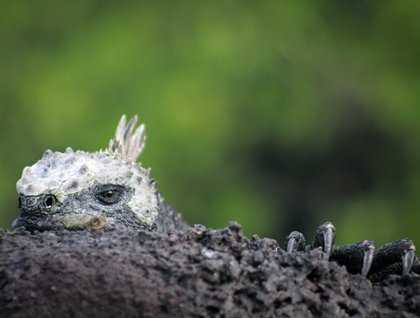We woke up to a wonderful landscape of the western islands of the enchanted archipelago, with the intention to visit the largest island of the Galapagos. We were surrounded by large volcanoes in the distance as we looked for ocean birds and activity on the flat seas of the west coast of the Galapagos. We soon crossed the equator line and returned to the southern hemisphere again. We arrived at the great protected bay known as at Punta Vicente Roca, where the titan cliffs surrounded our destination.
We decided to go on a Zodiac ride along the tuff cones of this young island. During the ride we were lucky to spot a manta ray, a few blue footed boobies, Galapagos penguins basking on the rocks while others were in the water cooling off, and a few sea turtles. We soon returned to this site to snorkel and saw plenty of Pacific green sea turtles. Some were resting on the bottom of the ocean and others just floating on the surface, all of which were getting very close to us while we were in the water. We were also fortunate to spot a couple of Galapagos penguins in the water.
We soon left our morning site and navigated to Fernandina Island, the youngest of the Galapagos. We had a dry landing at the only visitor site on this uninhabited island, a place known as “Espinoza Point”, where a large number of marine iguanas were sitting right in the middle of our trail. During our hike we spotted large colonies of marine iguanas, a few flightless cormorants resting within the few dry areas left by the pretty high spring tide we had on this island (we haven’t experience such a strong spring tide before). We even found marine iguana eggs washed up on the sand from their nests. Fernandina offers us the opportunity to imagine what it was like back in time, to the remote Galapagos where species have habituated and developed in abundance within their ecosystems. We certainly saw all of its wonders, including the large top land predator, the Galapagos hawk.







